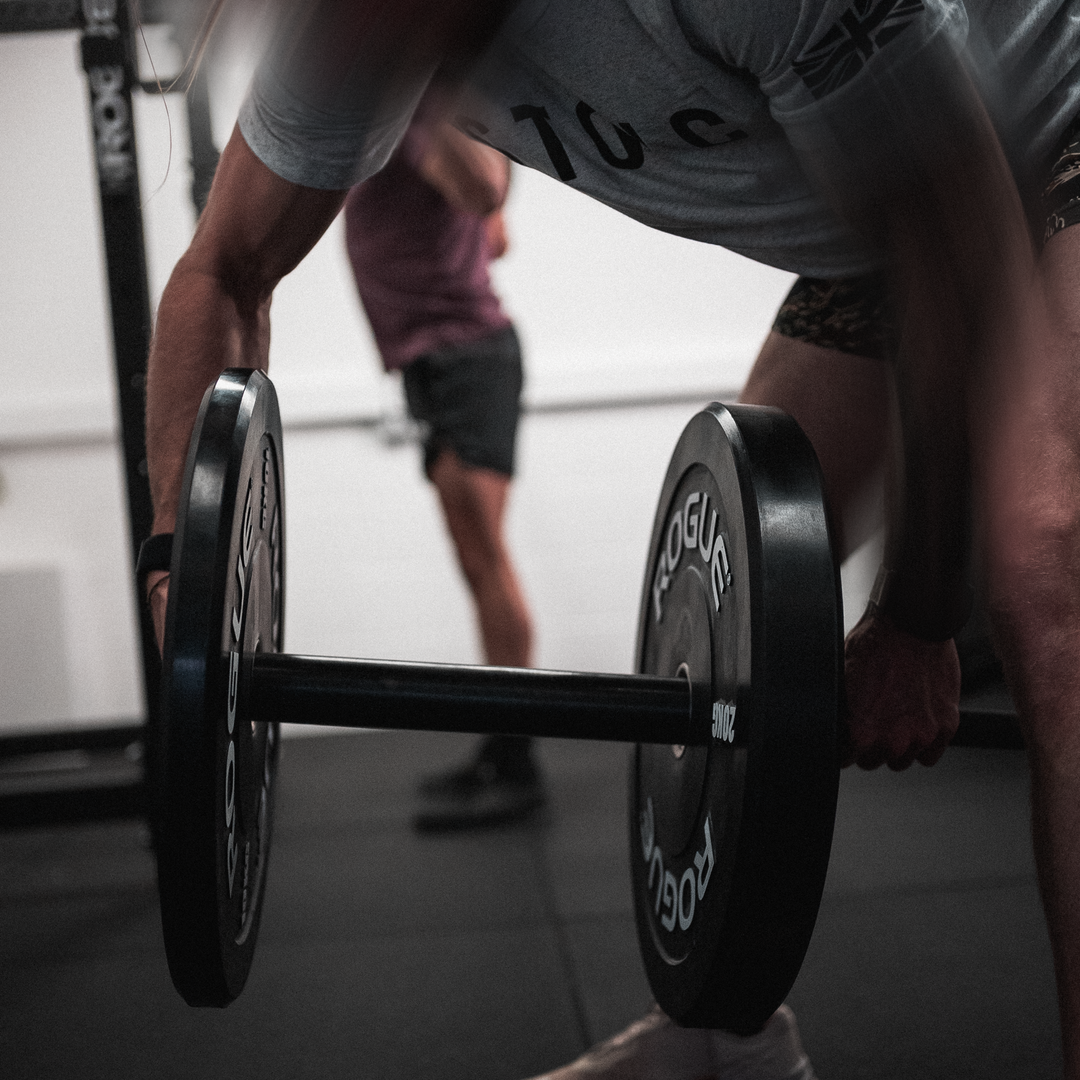WHY DONT WE USE PERCENTAGES TO GUIDE YOUR WEIGHT SELECTION

Introduction
Deciding on what weights you’re going to use in training can be an intricate and multifaceted process. The right choice can help you progress week to week, while the wrong one can sometimes hamper your development or even lead to injury.
In this article, we’re going to look at the various methods that are used for weight selection and go into detail on why we use rep ranges over any other method.
Methods of Selecting Weights
Percentages Based on One Rep Maxes
This method calculates the weight to be lifted based on a percentage of the individual’s one-repetition maximum (1RM) – the maximum amount of weight that can be lifted once. This technique is especially prevalent in structured disciplines like powerlifting and Olympic lifting.
Table 1: Example of Percentages of 1RM and Repetitions
| Percentage of 1RM | Repetitions |
| 60-70% | 12-15 |
| 70-80% | 8-12 |
| 80-90% | 4-8 |
| 90-100% | 1-3 |
Pros:
- Potential Precision: Easy to tailor weight selection to the individual’s capacity based on their previous lifts.
- Objectivity: Helps eradicate subjective feelings on the day.
- Ideal for Structured Training: Far better suited for athletes with more of a regimented weekly schedule, such as powerlifters or Olympic lifters.
Cons:
- Rigidity: Lack of flexibility for those with fluctuating schedules and lives, such as our community.
- Regular 1RM Testing: Requires constant assessment and reassessment to remain accurate which can be fatiguing.
- Not Adaptable: Difficult to implement when life and job variation is high and affecting the trainee’s nervous system.
Rep Ranges
Rep ranges are chosen from the desired outcome of training along the strength training continuum, whether it is strength, hypertrophy or endurance based. This can usually give the trainee a good enough target to aim for allowing them to self regulate their training a lot easier, especially if they are tracking their progress.
Table 2: Rep Ranges and Training Goals. (N.B. Rep ranges and goals overlap due to the varied nature of strength progression)
| Rep Range | Training Goal |
| 1-3 | Power/Absolute Strength |
| 2-8 | Strength/‘Functional’ Hypertrophy |
| 6-15 | Hypertrophy |
| 12-20+ | Strength Endurance |
Pros:
- Flexibility: This method allows for self adjustments based on your daily condition and schedule.
- Helps with Incremental Gains: Enables consistent weekly progression in more ways than just chasing numbers.
- Diverse Training Goals: Applicable to strength, hypertrophy, or endurance and can ignore the differences in genetics and fibre type that percentage based training falls prey to.
- More Than Weight: Focuses not only on weight increments but also technique, smoothness, time under tension, and other factors.
Cons:
- Trial and Error: This may require some experimentation initially to find the right weight. However, once that has been established and tracked it becomes far easier and quicker to make progress.
Rate of Perceived Exertion (RPE) Scales
The RPE method is a subjective way of assessing an individual’s effort level during exercise. Generally used in conditioning style training, it has shifted over to being used in the resistance training domain.
Instead of relying on specific quantitative measures like weight percentages or rep ranges, the RPE scale requires the trainee to gauge how hard they feel they are working.
Table 3: RPE Scale
| RPE | Effort Level |
| 1-3 | Very Easy |
| 4-6 | Moderate |
| 7-9 | Difficult |
| 10 | Maximum Effort |
Pros:
- Individualised: Adapts to personal perceptions of effort.
- Flexibility: Allows adaptation to daily fluctuations.
Cons:
- Can Be Complicated: Hard to directly associate RPE with reps. There would still need to be guidance in terms of reps or rep ranges to aim for along with the RPE rating for that given set.
- Subjectivity: Can be influenced by personal bias and effort.
- Inconsistency Across Individuals: Different people will rate the same effort levels differently.
- Depends on Daily Mental State: Factors such as stress, fatigue, motivation or caffeine levels can affect the perception of exertion, possibly leading to missing the session’s intention.
- Requires Experience: The accurate application of this method does need a good understanding of your body, which may be lacking in novices.
- Difficult to Quantify: Translating perceived exertion into specific weights can be challenging, making it harder to track progress over time.
Rep Ranges – Our Chosen Approach and How We Apply It
Strength is a skill. We say it all the time and always try to reinforce in our athletes and community that getting stronger entails far more than just chasing numbers. Especially since the people we primarily serve aren’t competing in events where they can set up a macrocycle training block to peak at 6 or 9 lifts in a single day.
Our community must be truly prepared for almost anything while not being overloaded by their training; therefore, our whole philosophy and mentality towards training differs from the status quo, meaning that the application of our training methodology must also differ.
Giving our athletes rep ranges to hit in a session, rather than using any other standard method allows for more flexible, adaptable, and self-regulated training.
Their consistent incremental performance can be more easily regulated by us and by them, allowing for continuous improvement. Using rep ranges also emphasises other important factors such as form, consistency, movement smoothness, and time under tension.
This is a sharp contrast to simply adjusting the weight autonomically based on a weight that was lifted once, at one time with a percentage that might have been set out 10-12 weeks prior, regardless of how that trainee is feeling on the day or what their day or week has been like.
Conclusion
Choosing the right weights is a nuanced task, with multiple methods offering unique advantages and limitations. While percentage-based approaches might suit structured sports like powerlifting, rep ranges offer the structure, adaptability, simplicity and consistency needed for our community who always have varied and ever-changing needs.
References
Baechle, T.R. and Earle, R.W., 2008. Essentials of Strength Training and Conditioning.
Zourdos, M.C., Jo, E., Khamoui, A.V., Lee, S.R., Park, B.S., Ormsbee, M.J., Panton, L.B., Contreras, R.J. and Kim, J.S., 2016. Modified Daily Undulating Periodization Model Produces Greater Performance Than a Traditional Configuration in Powerlifters. The Journal of Strength & Conditioning Research.
Hackett, D.A., Cobley, S., Davies, T.B., Michael, S., and Halaki, M. (2017) ‘Accuracy in Estimating Repetitions to Failure During Resistance Exercise’, Journal of Strength and Conditioning Research.
Ratamess, N.A. (2012) ACSM’s Foundations of Strength Training and Conditioning.
Helms, E.R., Storey, A., Cross, M.R., Brown, S.R., Lenetsky, S., Ramsay, H., Dillen, C., and Zourdos, M.C. (2016) ‘RPE and Velocity Relationships for the Back Squat, Bench Press, and Deadlift in Powerlifters’, The Journal of Strength & Conditioning Research.




